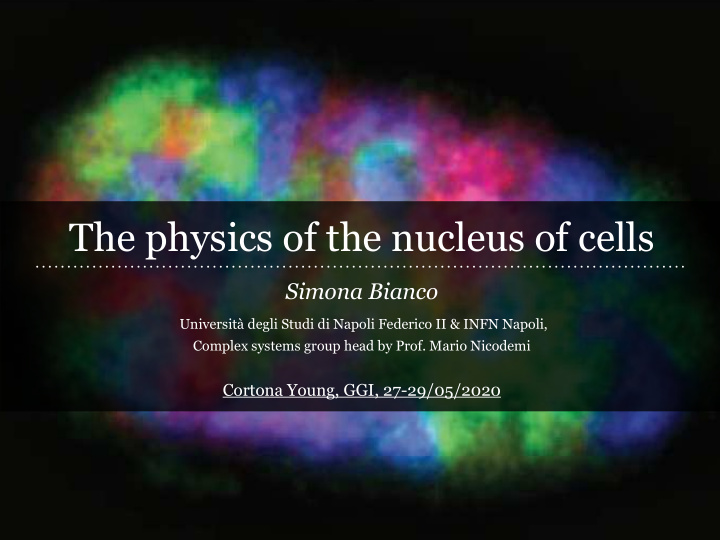



The physics of the nucleus of cells Simona Bianco Università degli Studi di Napoli Federico II & INFN Napoli, Complex systems group head by Prof. Mario Nicodemi Cortona Young, GGI, 27-29/05/2020
Chromosome organization in the cell nucleus Organization at the nuclear scale Cell nucleus by “FISH" microscopy Chromosomes territories 2 𝛎 m Chromosomes do not mix like spaghetti jumbled up in a bowl, but form chromosome territories . Misteli T, Scientific American 2011; Cremer T, Cremer C Nat Rev Genet 2001
Chromosome organization in the cell nucleus Organization at the chromosomal and sub-chromosomal scale Novel technologies such as Hi-C (Leiberman-A. et al. Science 2009) or GAM (Beagrie, …, Nicodemi, Pombo Nature 2017) return the contact probability between distal chromosome sites: Contact matrix of Chr11 110 Mb C(i,j) j i j Chromosomes are subdivided in topological domains (TADs) high contact probability 113 Mb 113 Mb 100 Mb i low Lieberman-Aiden et al. Science 2009; Dixon et al. Nature 2012; Nora et al. ibid. ; Beagrie, …, Nicodemi, Pombo Nature 2017
Chromosome organization in the cell nucleus Organization at the genes scale and its functional role Distal regulatory elements Gene Gene on Gene off Chromosomes 3D architecture influence key cell functions, such as gene regulation. Chromosomes mis-folding can lead to disease (e.g. congenital diseases and cancers). Dekker J et al. Science 20 08; Dekker J, Mirny L Cell 2016; Spielmann M et al. Nat Rev Genet 2018
The String&Binders (SBS) polymer model Theory: contact patterns emerge by the interactions between chromosomes and particles A chromosome is modelled as string loop String polymer (SAW) Particles (a gas of binders ) mediate interactions between the string sites binding sites Hamiltonian of the system: Binders H = H string + H free particles + H int Nicodemi M, Prisco A Biophys. J. 2009; Barbieri M et al. PNAS 2012
The String&Binders (SBS) polymer model SBS toy model Phase diagram String GLOBULE binder affinity, E int / k B T Θ point COIL Binders binder concentration [ c m , n mole/l ] Stable architectural classes of the system correspond to its emergent thermodynamics phases. Conformational changes can be controlled switch-like by, e.g., gene up/down-regulation (acting on c m ) or chemical modifications (acting on E int ) with no need of parameter fine-tuning. Chiariello A M, Bianco S et al. Sci. Rep. 2016; Barbieri M , Bianco S et al. Nature Struct. Mol. Biol. 2017
SBS reproduce experimental Hi-C patterns SBS model reproduce general Hi-C features, e.g. TADs contact matrix globule phase SAW SBS toy model 2 colors: green/red contact probability SBS model reproduce the folding of real genomic regions Hi-C Kcnj2 Slc39a11 Sox9 SBS 0 1 contact probability Chiariello A M, Bianco S et al. Sci. Rep. 2016; Barbieri M , Bianco S et al. Nature Struct. Mol. Biol. 2017
Prediction of the determinants of folding HoxB genes (1Mb region on chr11 in mouse embionic stem cells) Microscopy SBS model of the HoxB region globule phase Microscopy SBS prediction contact probability SBS model assuming homotypic contacts between “green" and “red” genes mediated by “green” and “red” particles The model predicted red/green particles have been discovered: “active” and Mediators of interactions “poised” genes (“red” and “green" polymerases) have been detected by triple co- “active” and localization experiments. “poised” polymerases Barbieri M, Bianco S et al. Nature Struct. Mol. Biol. 2017
Prediction of the effects of genomic mutations SBS model of a 6Mb region in human cells Hi-C SBS 0 1 100 nm duplication Bianco S, Chiariello A M et al. Nature Genetics 2018; Conte M, Fiorillo L, Bianco S et al. Nature Commun. 2020 in press
Prediction of the effects of genomic mutations SBS predicts the effects of a genomic SBS model of a 6Mb region duplication on 3D folding in human cells SBS Hi-C prediction Model predicted ectopic contacts ( black arrow ) are validated by independent Hi-C SBS Hi-C 0 1 100 nm duplication Bianco S, Chiariello A M et al. Nature Genetics 2018; Conte M, Fiorillo L, Bianco S et al. Nature Commun. 2020 in press
Summary ✓ Novel experiments have revealed the complex, functional 3D structures of chromosomes. ✓ The availability of rich new experimental data today allow to quantitatively study structural features of genomes. ✓ Theoretical physics play an important role in this field, as it provides principled models to explain the mechanisms behind data and to make quantitative predictions that can be tested by new experiments. ✓ We identified key physical mechanisms that determine genome spatial organization. Some of the molecules that locally drivers chromosomes organization predicted by the SBS model have been experimentally detected. Predictions on pathogenic genomic mutations have been validated by independent experiments.
Acknowledgements Mario Nicodemi ’s group, UniNa Andrea Maria Chiariello Carlo Annunziatella Andrea Esposito Luca Fiorillo Mattia Conte Francesco Musella Alex Abraham Raffaele Campanile Francesco Flora Eshan Irani (at MDC) Ana Pombo ’s group, Max-Delbrück Center, Berlin Main collaborations: Stefan Mundlos ’ group, Max Planck Institute, Berlin Bing Ren ’s group , University of California San Diego
Recommend
More recommend